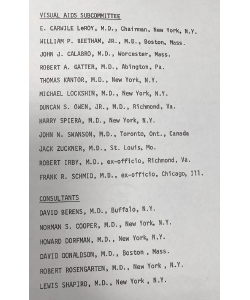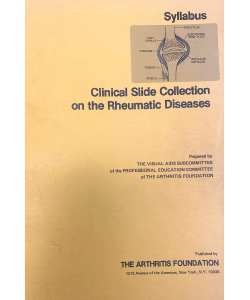Early Contributors
Early members of the subcommittee who contributed images to the collection included rheumatologists William Beetham Jr., John Calabro, Robert Gatter, E. Carwile Leroy, Currier McEwen, Michael Lockshin and Jack Zuckner. Other major contributors included pathologists and radiologists, notably David Berens, Norman Cooper and Howard Dorfman. Robert Rosengarten, a rheumatologist with a large private practice on Long Island, provided most of the early submissions from his personal large slide collection.

An early roster of the Visual Aids Subcommittee.

The original image collection was distributed in slide format with this publication.
To ensure the collection achieved the highest quality possible, professional photographers, Lester and Sylvia Bergman, were hired to create images with the precision and clarity needed to do what these collections were built to do—educate rheumatologists about the range of rheumatic diseases seen in the clinic daily.
Jane Diamond, managing editor of Arthritis & Rheumatology, actively contributed as project manager through many iterations of the collection.
The fertile ground on which this foundation was built is evident in the next iteration of the image collection. Using the vast changes and powers of technology, the image collection went digital and moved online in 2009.
Out of the Past
Numerous people helped build the Image Library as it evolved to its current form. A few of the contributors recently talked with The Rheumatologist about the contributions they made:
 Michael D. Lockshin, MD, is now the director of the Barbara Volcker Center, Hospital for Special Surgery, New York, and a professor of medicine and obstetrics-gynecology, Weill Cornell Medicine. As a rheumatology fellow at Columbia-Presbyterian Medical Center, New York, in 1968–70, Dr. Lockshin would often bring his camera to the clinical wards to photograph patients. His behavior caught the notice of E. Carwile Leroy, MD, soon to be department chair, who asked Dr. Lockshin in 1968 to join the Audiovisual Aids Subcommittee.
Michael D. Lockshin, MD, is now the director of the Barbara Volcker Center, Hospital for Special Surgery, New York, and a professor of medicine and obstetrics-gynecology, Weill Cornell Medicine. As a rheumatology fellow at Columbia-Presbyterian Medical Center, New York, in 1968–70, Dr. Lockshin would often bring his camera to the clinical wards to photograph patients. His behavior caught the notice of E. Carwile Leroy, MD, soon to be department chair, who asked Dr. Lockshin in 1968 to join the Audiovisual Aids Subcommittee.
‘By judicious cropping, tint & light control, & advice, the Bergmans, in those pre-Photoshop days, did amazing things with very marginal material.’ —Dr. Lockshin
Laying the foundation for the Image Library & its sustaining service to the field of rheumatology & other clinical areas took years of hard work, adherence to rigorous standards & a strong vision.
At that time, rheumatology was just on the cusp of being formally identified as a subspecialty of medicine, which occurred in 1972. “Because rheumatology was new and because relatively rare abnormalities in rheumatologic diseases are highly visible, the powers-that-be felt that a slide collection showing the abnormalities would be a valuable teaching tool,” said Dr. Lockshin, who chaired the subcommittee from 1972–75.
In 1972, the first clinical slide collection was assembled. The collection comprised 240 35 mm slides chosen from thousands submitted by 105 physicians. Of these 240 original slides, 191 remain in the Image Library—“a 50-year survival rate of 79%!” notes Dr. Lockshin. At a cost of just under $10,000, the Clinical Slide Collection on the Rheumatic Diseases was published as a syllabus by the Arthritis Foundation.


